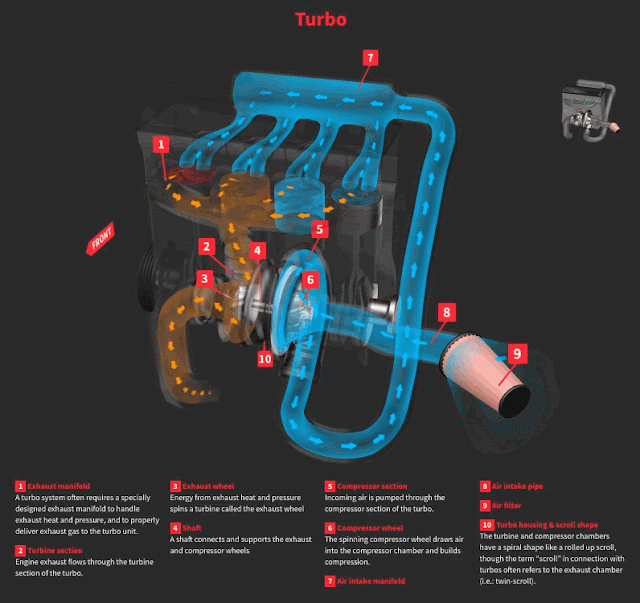How Does a Turbocharger Work?
A turbocharger is a forced induction system that uses exhaust gases to compress intake air, increasing engine power. Here’s the step-by-step process:
Exhaust Gas Flow: Hot exhaust spins the turbine wheel (up to 150,000–250,000 RPM).
Compressor Action: The connected compressor wheel draws in and pressurizes fresh air.
Air Cooling: Compressed air passes through an intercooler to reduce temperature (increasing density).
Engine Intake: Dense, oxygen-rich air enters the engine, allowing more fuel combustion → more power.
Key Principle: Recycles wasted exhaust energy to boost efficiency and power (20–50% increase in horsepower).
What Does a Turbocharger Do?
Increases Power: Adds 30–100+ HP (depending on boost pressure).
Improves Efficiency: Recovers wasted exhaust energy (better fuel economy in diesels).
Enhances Altitude Performance: Compensates for thin air at high elevations.
Reduces Emissions: Leaner combustion in diesels lowers CO₂.

Main Components of a Turbocharger
| Component | Function |
|---|---|
| Turbine Wheel | Spun by exhaust gases to drive the compressor. |
| Compressor Wheel | Pressurizes intake air. |
| Center Housing (CHRA) | Contains bearings and lubrication system. |
| Wastegate | Limits boost pressure by diverting excess exhaust. |
| Intercooler | Cools compressed air to increase density. |
| Blow-Off Valve (BOV) | Releases excess pressure when throttle closes. |
4. The 4 Types of Turbocharged Engines
Single-Turbo:
One turbo for balance of power and cost.
Example: Volkswagen 1.8T.
Twin-Turbo:
Two turbos (small + large or parallel) for reduced lag or high power.
Example: BMW N54 (parallel), Ford EcoBoost (sequential).
Variable Geometry Turbo (VGT):
Adjustable turbine vanes optimize boost at all RPMs.
Example: Porsche 911 Turbo, diesel trucks.
Electric Turbo:
Uses an electric motor to spool the turbo instantly (eliminates lag).
Example: Audi SQ7 (48V system).

Turbocharger vs. Supercharger
| Feature | Turbocharger | Supercharger |
|---|---|---|
| Power Source | Exhaust gases | Engine crankshaft (belt-driven) |
| Lag | Yes (spool-up time) | No (instant boost) |
| Efficiency | Higher (uses waste energy) | Lower (parasitic loss) |
| Complexity | More plumbing (intercooler, wastegate) | Simpler installation |
| Cost | Higher (for performance setups) | Lower (for basic kits) |
| Best For | Fuel economy, high-RPM power | Drag racing, low-end torque |
Winner?
Turbocharger: Modern cars, diesels, efficiency-focused builds.
Supercharger: Muscle cars, instant-response applications.
Key Takeaways
Turbos recycle exhaust energy for "free" power but suffer from lag.
Superchargers deliver instant boost but drain some engine power.
VGT and electric turbos are cutting-edge solutions for lag reduction.


Post a Comment